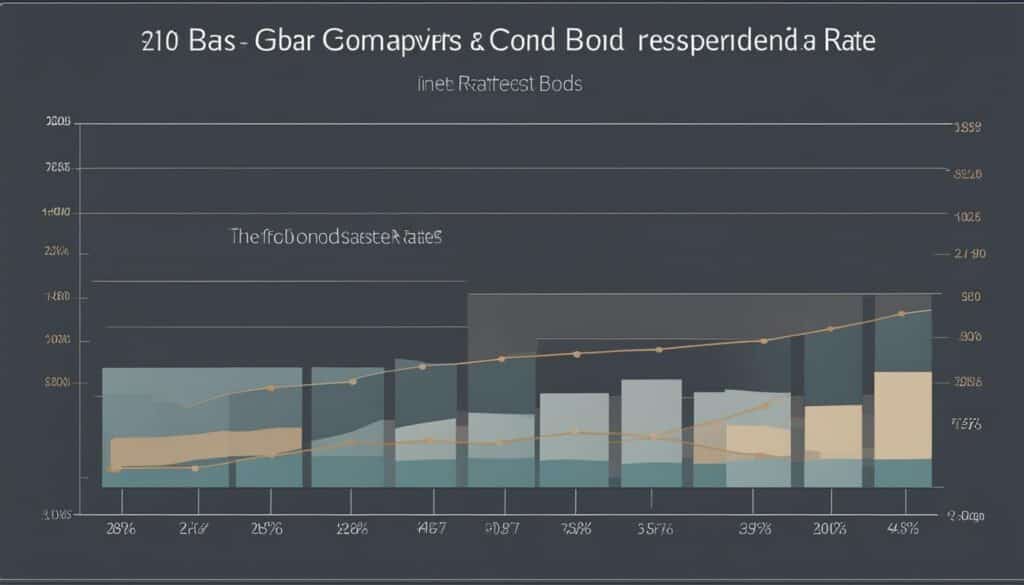Bond ratings play a crucial role in guiding investors in making informed decisions about their investments. When considering bonds for potential investment, it is essential to understand their credit quality and the associated risks. Bond ratings provide valuable insights into the creditworthiness of bond issuers and help investors assess the potential returns and risks of their investments.
Key Takeaways:
- Bond ratings are an important tool for evaluating credit risk in bond investments.
- Higher bond ratings indicate lower credit risk and may offer lower interest rates.
- Lower bond ratings imply higher credit risk and may result in higher interest rates.
- Investors use bond ratings to make informed decisions about portfolio allocations.
- Bond ratings help investors manage risk and align investments with financial objectives.
Understanding Bond Ratings and Their Significance
Bond ratings are a measure of credit risk assigned to bonds by credit rating agencies. These agencies assess the probability of default and assign ratings ranging from AAA (highest quality) to D (default). Investment-grade bonds are those rated BBB- or higher, indicating lower credit risk and better chances of repayment. Non-investment grade bonds, also known as high-yield or junk bonds, are rated below BBB-, implying higher credit risk and potential for higher returns. Investors use bond ratings to evaluate the creditworthiness of issuers and make investment decisions accordingly.
“Bond ratings are essential in assessing credit risk and determining the potential returns and risks associated with different bonds. By understanding bond ratings, investors can strategically allocate their investment capital to align with their risk tolerance and financial goals.”
Investors rely on bond ratings to gauge the creditworthiness of bond issuers. Higher-rated bonds offer a lower credit risk, providing a sense of security to investors as they have a reduced chance of default. Investment-grade bonds are often regarded as safer investments, appealing to risk-averse investors looking for stable returns.
On the other hand, non-investment grade bonds carry a higher credit risk due to their lower bond ratings. These bonds may be issued by companies with challenging credit profiles or those operating in high-risk industries. Investors seeking potentially higher returns are willing to take on the increased risk associated with non-investment grade bonds.
Bond ratings also influence the interest rates offered by bond issuers. Bonds with higher ratings generally provide lower interest rates, reflecting the lower perceived risk. In contrast, non-investment grade bonds offer higher interest rates to compensate investors for the higher credit risk involved.
By considering bond ratings, investors can make informed decisions about their investment portfolios. They can strategically diversify their holdings based on different bond ratings to manage risk effectively. Conservative investors may opt for investment-grade bonds to preserve capital, while more risk-tolerant investors may include higher-yielding non-investment grade bonds for potential enhanced returns.
Understanding bond ratings is crucial for investors as it helps them assess the creditworthiness of bond issuers, evaluate the risk-reward tradeoff, and make informed investment decisions. By incorporating bond ratings into their investment strategy, investors can mitigate credit risk and potentially maximize their returns.
The Impact of Bond Ratings on Interest Rates
Bond ratings play a crucial role in determining interest rates for investors. Understanding how bond ratings affect interest rates is essential for making informed investment decisions.
- Bonds with higher ratings offer lower interest rates:
- Bonds with lower ratings carry higher interest rates:
When a bond has a higher rating, it is considered less risky for investors. Therefore, issuers can offer lower interest rates on these bonds to attract buyers. Investors are willing to accept lower returns on highly-rated bonds because they have confidence in the issuer’s ability to repay the debt.
Conversely, bonds with lower ratings, such as non-investment grade or junk bonds, carry higher interest rates. The higher interest rates compensate investors for taking on the additional risk associated with these bonds. Issuers must offer attractive returns to attract investors despite the increased likelihood of default.
Overall, bond ratings have a direct impact on interest rates. Higher ratings result in lower interest rates, while lower ratings lead to higher interest rates. As an investor, it is important to consider bond ratings when assessing the potential returns and risks associated with different bond investments.
Now, let’s take a closer look at how specific bond ratings correspond to interest rates:
| Bond Rating | Interest Rate |
|---|---|
| AAA | 2.5% |
| AA | 3% |
| A | 3.5% |
| BBB | 4% |
| Non-investment grade | 6% |
Note: These interest rates are for illustrative purposes only and may not reflect current market conditions. They are provided to demonstrate the general relationship between bond ratings and interest rates.
As shown in the table above, higher-rated bonds such as AAA and AA tend to have lower interest rates compared to bonds with lower ratings. The interest rate increases as the creditworthiness of the bond decreases. It is crucial to consider this relationship when constructing an investment portfolio and determining the appropriate level of risk and return.
How Bond Ratings Influence Investment Portfolios
Bond ratings play a significant role in shaping investment portfolios. As an investor, I understand the importance of diversifying my risk and generating stable income. That’s why I often allocate a portion of my portfolio to fixed-income securities, including bonds.
When considering different bonds for my portfolio, I always take into account their bond ratings. These ratings help me assess the credit risk associated with each bond and make informed decisions about my portfolio allocation.
For conservative investors like me, investing in highly-rated bonds is a preferred strategy. Bonds with higher ratings indicate lower credit risk, meaning they have a lower probability of defaulting on their debt obligations. By choosing these bonds, I minimize the risk of losing my investment.
However, not all investors have the same risk tolerance or investment objectives. Some may be willing to take on higher risk in exchange for the potential of higher returns. These investors may consider including non-investment grade bonds, also known as high-yield or junk bonds, in their portfolios.
By diversifying my portfolio and including bonds with different ratings, I achieve a balanced mix of risk and potential returns. This diversification helps me manage risk effectively, avoiding overexposure to any single bond or credit rating category.
The Importance of Risk Management and Asset Allocation
When it comes to managing my investment portfolio, risk management and asset allocation are key considerations. Bond ratings provide me with valuable information to make well-informed decisions in these areas.
“Diversification is an essential strategy in managing investment risk. By including bonds with different ratings in your portfolio, you can spread your risk across various credit profiles and increase the likelihood of achieving your financial objectives.”
To illustrate the impact of bond ratings on investment portfolios, consider the following table:
| Bond Rating | Allocation Percentage |
|---|---|
| AAA – AA | 30% |
| A – BBB | 40% |
| Below BBB | 30% |
This table represents a hypothetical portfolio allocation strategy based on different bond ratings. By allocating 30% to bonds with the highest ratings (AAA – AA), 40% to bonds with ratings ranging from A to BBB, and 30% to bonds below BBB, I achieve an optimal balance of risk and potential returns within my portfolio.
As you can see, portfolio allocation based on bond ratings allows me to diversify my risk exposure, while also considering the potential returns associated with each credit rating category.
In summary, bond ratings have a significant influence on investment portfolios. By understanding and utilizing these ratings, investors can effectively manage risk, achieve their desired asset allocation, and align their investments with their financial goals.
Conclusion
Bond ratings play a pivotal role in the world of investments by enabling investors to assess credit risk and make well-informed decisions. Understanding bond ratings is essential for anyone seeking to navigate the realm of fixed-income securities and make savvy financial choices for a secure portfolio.
By considering bond ratings, investors can effectively manage risk and align their investments with their risk tolerance and financial objectives. These ratings also impact interest rates, helping investors determine the potential returns and risks associated with different bonds. Highly-rated bonds tend to offer lower interest rates, reflecting their lower credit risk, while lower-rated bonds carry higher interest rates to compensate for higher risk.
Furthermore, bond ratings inform investors in building well-diversified portfolios. By assessing the credit risk associated with different bonds, investors can allocate their assets strategically and minimize the risk of default. Conservative investors may prefer to invest in highly-rated bonds to prioritize stability and minimize risk, while those seeking higher returns may be willing to take on the increased risk associated with lower-rated bonds.
In summary, bond ratings serve as a crucial tool for risk assessment and investment decision-making. By comprehending these ratings, investors can assess credit risk, determine their investment strategy, and achieve their financial objectives. The ability to evaluate bond ratings is a valuable skill that empowers investors to navigate the complexities of the investment landscape and make optimal choices for their portfolios.
FAQ
What are bond ratings?
Bond ratings are a measure of credit risk assigned to bonds by credit rating agencies. These ratings indicate the probability of default and range from AAA (highest quality) to D (default).
How do bond ratings impact interest rates?
Bonds with higher ratings are considered safer investments and tend to offer lower interest rates. On the other hand, bonds with lower ratings carry higher interest rates to compensate for the higher risk associated with them.
Why are bond ratings important for investors?
Bond ratings help investors assess the credit risk associated with different bonds and make informed investment decisions. By considering bond ratings, investors can manage risk effectively and align their investments with their risk tolerance and financial objectives.
How do bond ratings influence investment portfolios?
Bond ratings play a significant role in shaping investment portfolios. Investors use bond ratings to diversify risk and generate stable income. Conservative investors may prefer highly-rated bonds to minimize the risk of default, while those seeking higher returns may be willing to take on the higher risk of non-investment grade bonds.
What is the significance of understanding bond ratings?
Understanding bond ratings is essential for anyone navigating the world of fixed-income securities. Bond ratings impact investment decisions, risk assessment, and the overall composition of investment portfolios.
Source Links
- https://www.bnnbloomberg.ca/pakistan-secures-final-imf-approval-for-700-million-loan-tranche-1.2020887
- https://www.bnnbloomberg.ca/private-credit-investors-fear-rate-cuts-may-come-too-late-1.2020903
- https://www.moneycontrol.com/news/business/markets/trade-setup-for-friday-15-things-to-know-before-opening-bell-15-12037261.html
Disclaimer
All information on this website is of a general nature. The information is not adapted to conditions that are specific to your person or entity. The information provided can not be considered as personal, professional or legal advice or investment advice to the user.
This website and all information is intended for educational purposes only and does not give financial advice. Signal Mastermind Signals is not a service to provide legal and financial advice; any information provided here is only the personal opinion of the author (not advice or financial advice in any sense, and in the sense of any act, ordinance or law of any country) and must not be used for financial activities. Signal Mastermind Signals does not offer, operate or provide financial, brokerage, commercial or investment services and is not a financial advisor. Rather, Signal Mastermind Signals is an educational site and a platform for exchanging Forex information. Whenever information is disclosed, whether express or implied, about profit or revenue, it is not a guarantee. No method or trading system ensures that it will generate a profit, so always remember that trade can lead to a loss. Trading responsibility, whether resulting in profits or losses, is yours and you must agree not to hold Signal Mastermind Signals or other information providers that are responsible in any way whatsoever. The use of the system means that the user accepts Disclaimer and Terms of Use.
Signal Mastermind Signals is not represented as a registered investment consultant or brokerage dealer nor offers to buy or sell any of the financial instruments mentioned in the service offered.
While Signal Mastermind Signals believes that the content provided is accurate, there are no explicit or implied warranties of accuracy. The information provided is believed to be reliable; Signal Mastermind Signals does not guarantee the accuracy or completeness of the information provided. Third parties refer to Signal Mastermind Signals to provide technology and information if a third party fails, and then there is a risk that the information may be delayed or not delivered at all.
All information and comments contained on this website, including but not limited to, opinions, analyzes, news, prices, research, and general, do not constitute investment advice or an invitation to buy or sell any type of instrument. Signal Mastermind Signals assumes no responsibility for any loss or damage that may result, directly or indirectly, from the use or dependence on such information.
All information contained on this web site is a personal opinion or belief of the author. None of these data is a recommendation or financial advice in any sense, also within the meaning of any commercial act or law. Writers, publishers and affiliates of Signal Mastermind Signals are not responsible for your trading in any way.
The information and opinions contained in the site are provided for information only and for educational reasons, should never be considered as direct or indirect advice to open a trading account and / or invest money in Forex trading with any Forex company . Signal Mastermind Signals assumes no responsibility for any decisions taken by the user to create a merchant account with any of the brokers listed on this website. Anyone who decides to set up a trading account or use the services, free of charge or paid, to any of the Broker companies mentioned on this website, bears full responsibility for their actions.
Any institution that offers a service and is listed on this website, including forex brokers, financial companies and other institutions, is present only for informational purposes. All ratings, ratings, banners, reviews, or other information found for any of the above-mentioned institutions are provided in a strictly objective manner and according to the best possible reflection of the materials on the official website of the company.
Forex/CFD trading is potentially high risk and may not be suitable for all investors. The high level of leverage can work both for and against traders. Before each Forex/CFD investment, you should carefully consider your goals, past experience and risk level. The opinions and data contained on this site should not be considered as suggestions or advice for the sale or purchase of currency or other instruments. Past results do not show or guarantee future results.
Neither Signal Mastermind Signals nor its affiliates ensure the accuracy of the content provided on this Site. You explicitly agree that viewing, visiting or using this website is at your own risk.




